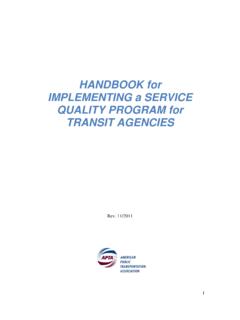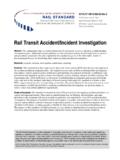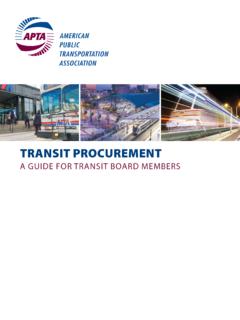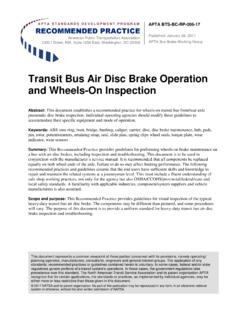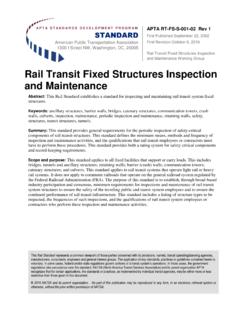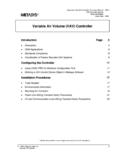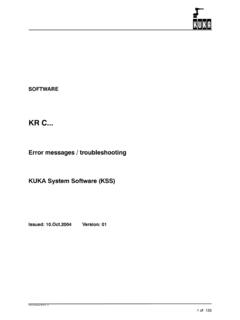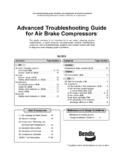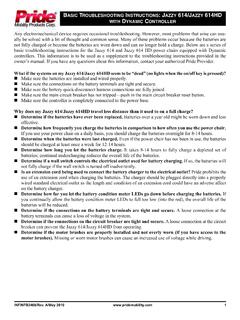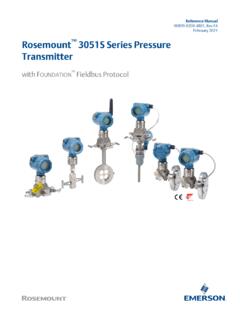Transcription of Electrical Circuit Troubleshooting
1 Electrical Circuit TroubleshootingAPTA Bus Technical Maintenance Committee WebinarM a r c h 3 1 , 2 0 2 0 Welcome Lisa JerramDirector-Bus Programs and Emerging Vehicle TechnologiesAPTAW ashington, DCStaff AdvisorAPTA Bus Technical Maintenance CommitteeElectrical Circuit Troubleshooting Webinar I 2 Housekeeping This webinar will be recordedand made available on APTA s website All attendee phone lines are muted To ask a question, use the Questions panel; questions will be answered at the end of the presentationsElectrical Circuit Troubleshooting Webinar I 3 ModeratorObed MejiaSenior Bus Equipment Maintenance Instructor LA MetroLos Angeles, CAVice Chair-Webinars APTA Bus Technical Maintenance CommitteeElectrical Circuit Troubleshooting Webinar I 4 ObjectivesAttendees will learn Circuit testing to identify open a voltage drop test to identify high resistance faulty ground conditionsElectrical Circuit Troubleshooting Webinar I 5 PresenterAndrew Warren, Maintenance InstructorLA MetroLos Angeles, CAElectrical Circuit Troubleshooting Webinar I 6 Introduction The most common Electrical Circuit faults you will encounter when working on bus Electrical systems are: open circuits; short circuits.
2 And high Circuit -any break (open) in the current path of a series Circuit makes the entire Circuit inoperative. In a parallel Circuit , only the branch effected by the open is Circuit -this can be a short-to-ground or short-to-voltage. This may cause a component to continuously operate regardless of switch position, or a fuse to repeatedly blow, depending on the Resistance -the load device does not receive the proper voltage/current to perform work and may operate sluggishly, dim, or not operate at Circuit Troubleshooting Webinar I 7 Open CircuitsA Circuit is said to be OPEN when a break exists in the path of current flow. Although an open occurs when a switch is used to de-energize a Circuit , an open may also develop accidentally. To restore a Circuit to proper operation, the open must be located and repairs circuits with an open check for: Loose connectors, pins and terminals Broken grounds Physical damage to the harness or vehicleElectrical Circuit Troubleshooting Webinar I 8 Troubleshooting an Open CircuitFind the open by measuring voltage level at the your way point by point toward the Circuit ground.
3 Until you find a point where voltage is no longer present. The open is between the last two measured points. Electrical Circuit Troubleshooting Webinar I 9 Troubleshooting an Open CircuitThe best method for diagnosing an open Circuit is by measuring voltage. When that is not possible, measure resistance following the steps the Circuit resistance between Circuit ground and a Circuit point closest to fuse; at this point you should measure OL or very high resistance. your way toward ground, point by point. Continue until you find a point where continuity is present. The open is between the last two measured points. From this point you may have to further isolate using the method Circuit Troubleshooting Webinar I 10 Short CircuitsA short Circuit is a fault that creates an unwanted path between two parts of a Circuit , or a short can bridge two circuits short can be: An unwanted path between part of a Circuit and ground (short to ground).
4 An unwanted path between two separate circuits (short to power/wire to wire). An unwanted path between two parts of a Circuit , some of the loads may be bypassed on Circuit . An unwanted current path inside a component, internal resistance of load too common short Circuit is short to ground. This short typically blows the Circuit fuse or pops the :It may not be possible to troubleshoot the Circuit under its own Circuit Troubleshooting Webinar I 11 Short CircuitsIn circuits with a short-to-ground or voltage, check for: Previous repairs. Physical damage to the harness or vehicle. Equipment installed with sheet metal screws that have pierced a Circuit Troubleshooting Webinar I 12 Troubleshooting a Short in Series CircuitThe Circuit shown is shorting to ground before the load. The short can be found in one of two ways: Checking resistance Using an external loadElectrical Circuit Troubleshooting Webinar I 13 Troubleshooting a Short in Series Circuit External LoadFor some faults, using tools other than a DMM may help diagnose a fault faster.
5 If there is a short to ground in a series Circuit , a test light may help you pinpoint the short Remove the Jumper in an external load (a light works well for this).3. Apply power to the Circuit -the light will turn Start by disconnecting the connection point closest to the external load and work your way towards The light will continue to remain lit when you disconnect the section past the Circuit Troubleshooting Webinar I 14 Troubleshooting a Short in Series Circuit External LoadElectrical Circuit Troubleshooting Webinar I 15 Troubleshooting a Short in Series Circuit Measuring ResistanceIf a Circuit has a high resistance, then we could use a DMM to help locate which part of the Circuit has the fault. Set the DMM to read Ohms, and then remove all voltage from the Circuit by disconnecting the batteries or removing the Disconnect the connection point closest to the power Connect the meter to the connection point closest to the power source and : The measured resistance here should be close to 0.
6 Leave the meter in Disconnect the next accessible connection point moving towards The point where continuity is lost is where the short is Circuit Troubleshooting Webinar I 16 Unwanted Resistance Circuit FaultsUnwanted resistance in a Circuit can prevent it from operating normally. Unwanted resistance in a Circuit can be a poor connection, burned pin, corroded wire / terminal or a faulty component. Normal Resistance in a healthy Circuit should be very close to 0 ohms using no voltage when the Circuit in ON. Higher resistance indicates a possible problem. A dim bulb can be an indicator of high unwanted resistance can best be detected when the Circuit is ON by performing voltage drop measurements. Electrical Circuit Troubleshooting Webinar I 17 Unwanted Resistance Circuit FaultUnwanted Resistance Faults cause a load to perform less work than it was intended to and is caused in most cases by: Loose or corroded connector Improper wiring repair Internal wire corrosion Defective LoadNote in a lot of cases unwanted resistance increases as the temperature of the Circuit increases during operation.
7 Electrical Circuit Troubleshooting Webinar I 18 Unwanted Resistance Circuit FaultThe best way to diagnose unwanted resistance faults is by measuring voltage:Source voltage -this is the voltage measured at the beginning of the voltage -this is the voltage available to the voltage drop -this is the voltage used by the Circuit Troubleshooting Webinar I 19 Voltage Drop Measurements Measuring voltage drop is one of the most useful tests you can perform. A voltage drop test checks for loss of voltage in each portion of the Circuit while the Circuit is connected, powered and : Voltage drop testing requires you to back probe, all components remain connected during voltage drop test is done as the positive lead in the most positive section of the Circuit you are the ground lead on the most negative section of the Circuit you are the Circuit with the meter leads in place and note the that voltage dropped is voltage consumed by resistance in the Circuit Troubleshooting Webinar I 20 Measuring Source VoltageThis measurement is done at the source of voltageFor the Circuit .
8 This could be Panel ModuleThis test is considered voltage drop because you are measuring the drop between the source and ground. Circuit voltage drop should equal source Circuit Troubleshooting Webinar I 21 Measuring Available VoltageThis measurement is done at the component. This is the amount of voltage available to the component to operate. This reading should be just under what the source measurement Circuit Troubleshooting Webinar I 22 Measuring Voltage DropVoltage drop is the amount of voltage consumed by the Circuit . Voltage drop of individual components, sections of Circuit or connections. Voltage drop is voltage consumed. Voltage should only drop at the load in a Circuit . Voltage drop in other areas indicates high should only be used at the loads; voltage used in other areas such as connectors or wiring is unwanted resistance.
9 Electrical Circuit Troubleshooting Webinar I 23 Measuring Voltage DropVoltage drop thru connections should be minimal close to Circuit Troubleshooting Webinar I 24 High Resistance on Ground SampleThis sample shows the light is inoperative even though the Circuit is testing the source voltage, available voltage, and voltage drop of the light the condition was isolated to a faulty ground shown by the meter volts are being used on the ground side of the Circuit not leaving enough voltage for the light bulb to Circuit Troubleshooting Webinar I 25 Avoid Open Circuit MeasurementsBefore we get started, keep in mind that, when performing voltage measurements, the Circuit must be though you have heard it, done it, and seen it before, do not disconnect wires to check for is a common mistake; the readings will be open Circuit readings.
10 Any resistance in the Circuit unless proportionally high in comparison to the meter internal resistance will not be Circuit Troubleshooting Webinar I 26 Open Circuit Reading Bad Experience Condition: No Start -Repeat Road mechanic is working on a No Start condition on a Cummins gas engine. During the diagnosis, an active code for throttle plate position sensor low input voltage is found. As part of the diagnostic procedure, the mechanic checks for available voltage tothe throttle plate and measures Since there is full battery voltage available to the throttle, the mechanic concludes that the throttle plate is defective and needs replacement. The mechanic replaces the throttle plate, but the No Start condition does not go away. What did the mechanic do wrong? As part of the diagnostic process, the mechanic checked available voltage to the throttle plate and found volts.
